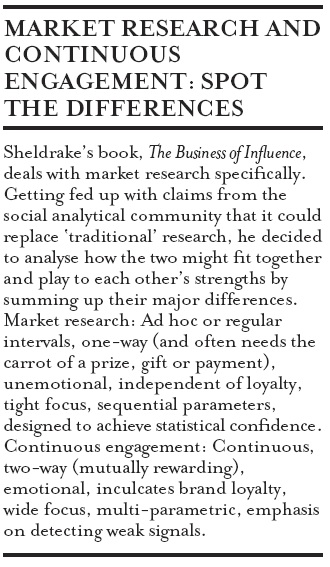Robert Heeg
Don’t let Meanwhile’s new snazzy Manchester Square headquarters fool you. Unlike many of its competitors, the London-based marketing and PR consultancy does not try to dazzle its clients with vague trendiness or hip interiors. In a refreshing look on marketing and PR, Meanwhile uses rigorous, fact-based methodology to analyse its clients needs. No wonder, when one of its founders is Philip Sheldrake, a chartered engineer with a passion for innovation and an equal interest in marketing and public relations. “I felt the communication of innovation was lacklustre. So I moved into PR, just to see if I could communicate the benefits of innovation, better than was achieved before.” With a smile he adds: “Also, I’m a geek, which is why I got heavily into the web.”
At Meanwhile they’re pioneering a creative approach to marketing and PR, which allows the consultancy to align, with rigorous research and measurement, activities with its commercial partners. “Our partners’ success is our success, and the same goes for failure.” They call this ‘venture marketing’; doing what it takes with their partners in order to identify the best products to bring to market, with an optimal mix of skills. This can include traditional or digital advertising, branding expertise, or other digital skills. By converging all these, the deal can then be structured so that successes and failures are shared with Meanwhile’s clients. ‘Brutal alignment’, is another favourite catchphrase. “If our customer tries to sell coffee, then we try to sell coffee. In the same kind of way venture capitalists or private equity companies do, which is why we call it venture marketing.”
Perfect storm
Sheldrake feels that creativity is best measured by relevant metrics, because creativity isn’t all that creative when it doesn’t achieve what a business needs. “There are countless advertising campaigns that have won Cannes awards, but without a blip on the sales line, it was an utter failure as far as we’re concerned. We’re not trying to win awards, we’re trying to help our customers succeed at what they do. If it doesn’t work, we change it within a week, not months.”
Sheldrake strongly disagrees with those in advertising who claim that creativity cannot be measured. “The maxim for the 21st century was: I know half my advertising works, I just don’t know which half. In the 21st century we have technology such as social media, number crunching capability, the ability to collect big data and analyse it. Coupled with a new understanding of best practice, structure formulation, alignment and execution, and with frameworks like the Balanced Scorecard, there’s no reason whatsoever why marketing and PR should be the last bastion of science.”
Technology, rigour and discipline have permeated every aspect of business, and Sheldrake feels that it’s now marketing and PR’s time. “It’s a perfect storm, and either you get it, or you do something else.” He urges organisations to ‘change before that start-up changes you’. A message that can be painful for marketing and other departments. But at Meanwhile they never intended to be everything for all people. “Some don’t like the brutality and aggression of our approach. Others want a return on their investments. And if you don’t understand how to measure a performance, then you don’t know if you’ll get a return next year. That’s a missed opportunity.”
Data exaflood
Today, we have more data at our disposal than ever before. Sheldrake wrote about this in his chapter on digital marketing for the book The Marketing Century. He mentioned the Tesco Club Card, a loyalty card by the leading UK supermarket, and how it created a massive database of people’s purchasing habits, and thereby became a prime example of CRM and retail analytics. “They say Tesco can work out when a woman might be pregnant before she knows it herself, by spotting slight differences in her purchasing patterns. That is probably just a myth, but it does make you think about what’s possible with a big set of data to crunch.”
Over the next few years we’re going to have masses more data. Combine that with a vision some call pervasive computing, where the room we sit in is an interface to the web, picking up gestures without a screen, and we’ll have a so-called exaflood of big data that, Sheldrake thinks, will remove one of the reasons we did market research in the 20th century. “Rather than a lack of data, in the 21st century we’ll struggle with having too much. Knowing how to convert data to information to knowledge to wisdom will be the challenge, not necessarily getting hold of the data in the first place.”
Web 3.0
Despite the freely available data, Sheldrake’s message at the ESOMAR 3D event in Miami will not be a gloomy one for market researchers. “Like other lemmings I could say: ‘Market research is dead, long live social analytics!’ But I would be wrong. Because actually, social analytics is a powerful tool when combined with retail analytics and other business intelligence. There are still aspects of market research you can’t replace. Therefore, the two have to meld together beautifully. In fact, they work best together, rather than apart in silo’s.”
It seems that we increasingly know more and more about less and less. Sheldrake agrees to a point, but predicts that the web will create its own order in the chaos. “Just talking about the volume of data, we may ask: where is the quality? But interestingly we also see a group of technologies coming together that are loosely called the semantic web, or the web of data. After web 1.0 and 2.0, web 3.0 describes the vision of the web itself understanding the meaning of all the data and participation online, using semantic web technologies. So now the web can start to spot memes, themes and correlations, and present those to us, rather than wait for us to stumble across them. That’s a very powerful vision, for instance for cancer scientists posting all their findings and data online.”
Fingers crossed
He called his latest book the Business of Influence because he sees influence as the common denominator that links all the silo’s that emerged in the 20th century; advertising, media relations, investor relations, customer service, and so on. “There was no joined-up thinking. An organisation is not an island. It interacts with stakeholders, second by second. It needs to influence those stakeholders, and systematically ensure it’s influenced back.”
the silo’s that emerged in the 20th century; advertising, media relations, investor relations, customer service, and so on. “There was no joined-up thinking. An organisation is not an island. It interacts with stakeholders, second by second. It needs to influence those stakeholders, and systematically ensure it’s influenced back.”
The Business of Influence tries to break down the silo’s and get a more converged approach. Sheldrake linked it to the Balanced Scorecard, which is the dominant framework for business performance management. The Influence Scorecard then helps to instil a way for organisations to align their marketing and PR functions, with business needs, measurably and accountably, in a way that hasn’t been achieved before. “This explains why you just about see the CMO at the board table, but not the head of comms or PR. These people typically haven’t spoken the language of the business around them. ‘Fingers crossed that something might work’ is no longer sufficient.” Likewise, the head of market research is often absent at the board table, a fact Sheldrake laments. “For an organisation to underplay research – the communication with its stakeholders – is to ignore the environment it sits in. It’s negligent.”
Philip Sheldrake is a chartered engineer, a founding partner of the marketing and communications consultancy Meanwhile, a main board director of Intellect, the UK trade association for the technology industry, and board director of 6UK, a government backed non–profit to promote adoption of the new Internet protocol in the UK. Philip authored The Social Web Analytics eBook 2008, and the digital marketing chapter of The Marketing Century, a book celebrating the centenary of the Chartered Institute of Marketing. He chairs the Chartered Institute of Public Relations group on measurement and evaluation, and designs and chairs Internetome, the Internet of Things Conference. This year he published his book The Business of Influence: Reframing Marketing and PR for the Digital Age.


